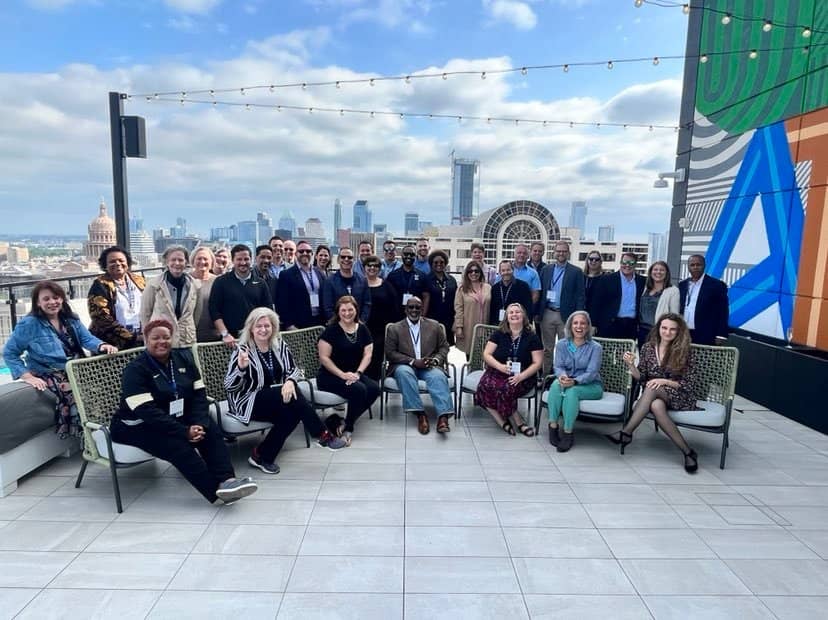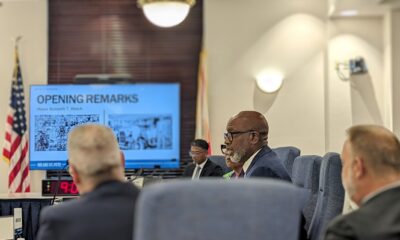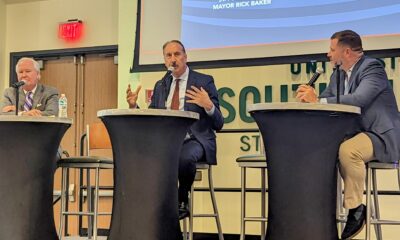Thrive
Unpacking Austin: What did St. Pete learn?

As soon as the St. Petersburg Area Chamber of Commerce members arrived in Austin, Texas April 24, there wasn’t an immediate, striking resemblance to the Sunshine City – that was until Austin’s thought leaders unpacked the rich history and challenges the peer cities share.
“One of the goals of our ‘Thinking Outside the Burg trip’ to Austin was to learn about the rapid development and growth of the city over the past 10 – 20 years. It has been often noted that Austin and St. Pete are very similar in their culture and vibes,” said Christie Bruner, VP of advocacy at the Chamber.
“When the choice was made to go to Austin and our team started learning about the stakeholders and top issues of the city, we knew right away that the parallels between our cities went much deeper than any of us imagined.”
The City of Austin, which calls itself “The Live Music Capital of the World,” has a diverse population mix of musicians, artists, college students, government employees and those in the tech space.
“We are both blueberries in a tomato soup,” Chamber President Chris Steinocher commented, comparing the two largely democratic cities.
Reminisces of Gas Plant District?
Over 50 St. Petersburg business leaders, including St. Petersburg Mayor Ken Welch, University of South Florida St. Petersburg Regional Chancellor Christian Hardigree and Innovation District Director Alison Barlow, attended the three-day benchmarking trip.
The itinerary listed back-to-back meetings with Austin Mayor Kirk Watson, Austin Chamber of Commerce members, officials spearheading Austin’s most transformative project, and entrepreneurs and college executives creating a paradigm shift in the city’s economy.
An hour after arriving in Austin, the members made their first stop at Mueller, a 700-acre site in the heart of Austin that’s being transformed into a master-planned community with mixed-income housing with homes for rent and sale, retail stores, a grocer and more.
The site once served as the city’s old Robert Mueller Municipal Airport, decommissioned in 1999.

Welch (center) and Chamber members view a 3D model of downtown Austin.
Some of the local attendees said Mueller mirrors the plans of transforming the Gas Plant District/Tropicana Field into a vibrant destination – although the Meuller site is six times larger in scale.
The vision for Mueller was born in 1984 out of the Citizens for Airport Relocation (CARE) plan, which called for a higher-density development within the surrounding neighborhoods.
In 2000, the City of Austin approved the reuse and redevelopment plans through a committee. Two years later, it started working with Catellus Development Corporation as the master developer.
In a similar private-public-partnership play, the Welch administration is working towards an agreement with the Tampa Bay Rays and Hines development team to redevelop the 86-acre Tropicana Field site.
East Austin also echoes a harrowing history with the dividing interstate system. Austin’s I-375, constructed in 1962, split the impoverished east-side community from its more affluent neighbors, further deepening the rooted racism in the city.
Likewise, Tampa Bay’s I-175 bisects the City of St. Petersburg, creating an impermeable barrier. The interstate crippled the historic African American-owned business district, the Deuces Live Main Street, segregating it from the rest of downtown.
Rethinking affordability
The business people who have climbed the corporate totem pole and earn a sizeable salary reside in the downtown core; meanwhile, many other residents serving in the public services space have to live beyond the shadows of the bustling city.
“St. Petersburg is already there,” Hardigree said about how the city’s escalating cost is pushing residents to seek housing elsewhere.
However, Austin is gauging the affordable housing inventory with a microscopic focus comparing the districts.
“Their data analytics on housing are incredible,” Barlow said, sharing an image of the Austin Strategic Housing Blueprint Scorecard, which displays the city’s 10-year goals and latest progress.
“On a dashboard, they list their different districts for councilmembers to know how their districts are performing against the goals,” Barlow said, explaining Austin’s dashboard has been verified multiple times, becoming a solid tool to grasp the metrics and form meaningful conversations.
One tactic the city is embracing is adaptive reuse.
“They have closed schools because of the lack of demand. The families they serve aren’t living in Austin; they are in the suburbs,” Steinocher said, describing how the Austin Independent School District is developing a handful of its schools into affordable housing for teachers.
“It’s creative, but it’s very eye-opening that families can’t afford to live in Austin right now,” Steinocher said. “Like us, affordability is still elusive to them as well.”
Hardigree, who previously lived in Dallas, noted how Pinellas County Schools (PCS) is also adopting this concept with plans to convert the 99-year-old Tomlinson Adult Education Center into affordable apartments for its teachers and staff.
“If something hasn’t been utilized, they’ve thought about how it can serve a better use and that’s what they’ve done with these schools. People want to work and play where they live. No one wants a 40-minute commute,” Hardigree said. “I think it makes sense for us to be competitive and explore the other things we can do with spaces that are no longer viable in the original way they were created. As a community, we need to come up with the strategies that provide access here. For us, it’s particularly important [to have a reasonable cost of living] because we don’t want to export our intellectual capital and circulate these students out.”
The members also engaged with Austin Community College executives, who shared how the college has reengineered Austin’s Highland Mall into a college campus that houses the college’s nursing and culinary programs. The planning began over a decade ago when ACC started buying sections of the property.
“They [the city] believe the success to affordability is to equip the residents with skills so they can get the types of jobs the city is attracting downtown,” Steinocher said.
The city has also amplified this effort by helping high school students complete FAFSA (Free Application for Federal Student Aid) forms. Federal Student Aid is the largest financial enrollment program for college students in the U.S.
“They know if someone completes the FAFSA forms, they are more inclined to graduate high school and go to college,” Steinocher said.
Defining innovation in one’s city
On the third day, the attendees toured Capital Factory, which has 81,000 square feet of co-working space and hundreds of startups.
The hub refers to itself as the “center of gravity for entrepreneurs in Texas.”

The chamber members inside the Capital Factory in Austin.
“The tech community is blossoming. Like-minded people like to recruit the same types of companies and entrepreneurs,” Barlow said. “I feel we are doing something similar with the Hub. They are doing it on a much bigger scale with having the innovation arm of large corporations operate in the Factory.
“The way people work nowadays isn’t the routine 9-to-5 job in an office, so you need to create a reason for people to coalesce,” Barlow said about the programming for the space. “Their innovation district is structured differently than ours. We are becoming established in a more structured holistic way.”
The 150-plus mentors in the Capital Factory specialize in government and military, virtual reality, digital health and more.
Capital Factory hosts over 900 tech-focused events, including SXSW (South by Southwest), the world-renowned annual celebration of art and tech.
Barlow said she was also inspired by Capital Factory’s ability to create a longstanding venture fund.
Next steps
“The most valuable takeaway from the trip for me was the importance of collaboration. It was apparent that cross-sector collaboration was important for many of the topics discussed, including transportation, housing, education and more. Not only did several organizations collaborate to ensure the best outcomes, but government at the local, county and state level worked together with both the for profit and non-profit sectors on various projects,” Bruner said. “Of course, we heard stories about programs and initiatives that did not have the intended outcome or were not completed as desired – but those projects are sources of learning and growing as well.”
As a result of the trip, Bruner said the Chamber will process the lessons and continue to collaborate at the local level on several of its priorities, including increasing attainable employee housing, and amplifying regional connectivity and public transit.








Steve D
May 4, 2023at7:54 am
Hopefully, St. Pete won’t defund the police like Austin did. Violent crime and residential burglary there are out of control and unimportant to the leadership. Our friends are moving to a far suburb to protect themselves, and they never go downtown to the music district. Same result for friends of ours in Nashville,TN.
John Donovan
May 2, 2023at5:50 pm
How much is the income tax in Illinois?
Illinois income tax:
4.95 percent
How is income taxed in Illinois? Illinois’ flat income tax rate means that every resident, regardless of income level, pays the same individual income tax rate of 4.95 percent.Feb 7, 2023
Illinois State Tax Guide: What You’ll Pay in 2023
AARP
https://states.aarp.org › illinois › state-taxes-guide
John Donovan
May 2, 2023at5:49 pm
Chicago / Cook county 10.25%
What is the sales tax rate in Cook County? The minimum combined 2023 sales tax rate for Cook County, Illinois is 10.25%. This is the total of state and county sales tax rates. The Illinois state sales tax rate is currently 6.25%.
Cook County, Illinois Sales Tax Rate (2023) – Avalara
avalara.com
https://www.avalara.com › state-rates › illinois › counties
John Donovan
May 2, 2023at5:48 pm
Tomato soup? One of the reasons Texas prospers is this: Texas does not have an individual income tax. Texas does not have a corporate income tax but does levy a gross receipts tax. Texas has a 6.25 percent state sales tax rate, a max local sales tax rate of 2.00 percent, and an average combined state and local sales tax rate of 8.20 percent.
Texas Tax Rates & Rankings | Texas State Taxes
Tax Foundation
https://taxfoundation.org › state › texas
Darren
May 2, 2023at3:40 pm
Very familiar with Austin….don’t go there!!
Pat O'Brien
May 2, 2023at3:38 pm
Hope you learned not to do anything like Austin has done!
Jim
May 2, 2023at2:56 pm
The city should be careful not to copy too much from Austin. The roads there are in terrible condition, parking is immensely worse there, and there’s better public transit in St. Pete. Zero infrastructure is also going into the city despite massive cookie cutter apartment buildings going up on plops of land simply because they fit, meanwhile their pipes burst in fits of cold. Austin’s modus operandi is not sustainable.
Mj
May 2, 2023at2:51 pm
Im part of the residue left in East Austin. If the change is coming to accommodate those who need affordable housing I’ve yet to see it. Our city grew so fast. The governing few only saw dollars. Too little too late.
steve sullivan
May 2, 2023at1:57 pm
Great that you went to Austin but it looks to me like there aren’t any tangible solutions that was gained that would benefit the Burg. Please don’t try and copy their blueprint. Grow things organically here in the Burg. There is a solution for housing but do you have the courage to make the hard decisions. Please realize that the decisions you made a decade ago regarding short term rentals has come back to bite you. Airbnb’s took several thousand rental and residential units off the market, hence your increase in home and rental prices. That was then made worse by the Baine Capital, JP Morgan and Blackrock’s of the world buying up whole neighborhoods and turning them into high priced rentals